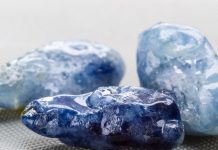
Amber stone is an exciting and sought-after stone to be wire-wrapped and made into jewelry. It is appreciated for its wonderful shades of color from deep yellow to reddish-orange and in some cases brown. Made popular by the Jurassic Park movies, to paleontologists, it is a look back in time, a snapshot of prehistoric insect life.
What is Amber?

Amber is fossilized tree sap or resin. Nearly all amber comes from coniferous trees. The resin comes mainly from damage to the bark of the tree. For instance, when a live pine branch is broken, sap runs out of the wound. This yellowish resin hardens to protect the tree and prevent further damage.
The resin also has antiseptic properties to help heal the tree. The resin is also very sticky and will trap insects and other debris such as seeds and leaves that may encounter it. In some cases, air will become trapped as the sap flows, creating bubbles. On rare occasions, water is trapped in the bubbles creating enhydros, liquid water inside the air bubbles. Paleontologists can study these air bubbles and water to see what the ancient environment was like.
The resin also may have flowed several times creating layers trapping various insects on different layers. When an abundance of resin flows, it may even drip and fall to the forest floor trapping dirt, leaves, seeds and other organic material.
 Ancient Amber
Ancient Amber
As ancient trees died and fell to the ground or individual pieces dried and fell to the forest floor, resin-covered trees were washed into streams and rivers and were buried in sedimentary deposits.
Amber dates from around one million years ago to around 300 million years ago, so there is a wide variety of organic matter that has been trapped. Trapped organic matter is called an inclusion.
Where is Amber Stone Found?
Amber can be found in some parts of the world in great abundance. When found, it can have many shapes including irregular nodules, blobs, large thin sheets and even a drop-like shape.
The Baltic region produces most of the commercially available amber. Areas around Russia, Lithuania and Poland are major sources of amber.
The area of what is now the Baltic Sea was dry land millions of years ago. The area was populated with animals, plants and conifer trees. Later, when large amounts of ice melted, the sea level rose and began washing amber and other fossils onto the beaches.
Today, fishermen with their drag nets are hauling in Ice Age bones and other fossils as they fish.
So much amber has been found that many European palaces are adorned with amber lamps, furniture, picture frames, artworks, sculptures and jewelry. Entire rooms have even been filled with amber.
 Amber Properties
Amber Properties
Amber has a Mohs hardness of 2 to 2.5.
It is an organic substance and it does retain its chemical composition for some time. As it hardens the resin molecules link with others to form larger molecules in a process called polymerization. This slow process can take several tens of thousands to millions of years.
After it polymerizes, the amber becomes less soluble in various organic solvents. This means that it will not become sticky when in contact with toluene, acetone, alcohol or other solvents. Copal or what some call “young amber” will get softer and sticky when in contact with organic solvents. Copal is sometimes desired for jewelry making as real amber is far too brittle and tends to shatter.
Young amber is not considered true amber and comes mostly from Columbia and Madagascar. True amber for lapidary uses comes from the Baltic and the Dominican Republic. Amber can be polished and often it will reveal treasures inside that can tell us about prehistoric times.
This story about amber stone previously appeared in Rock & Gem magazine. Click here to subscribe. Story by Joseph “PaleoJoe” Kchodl.













